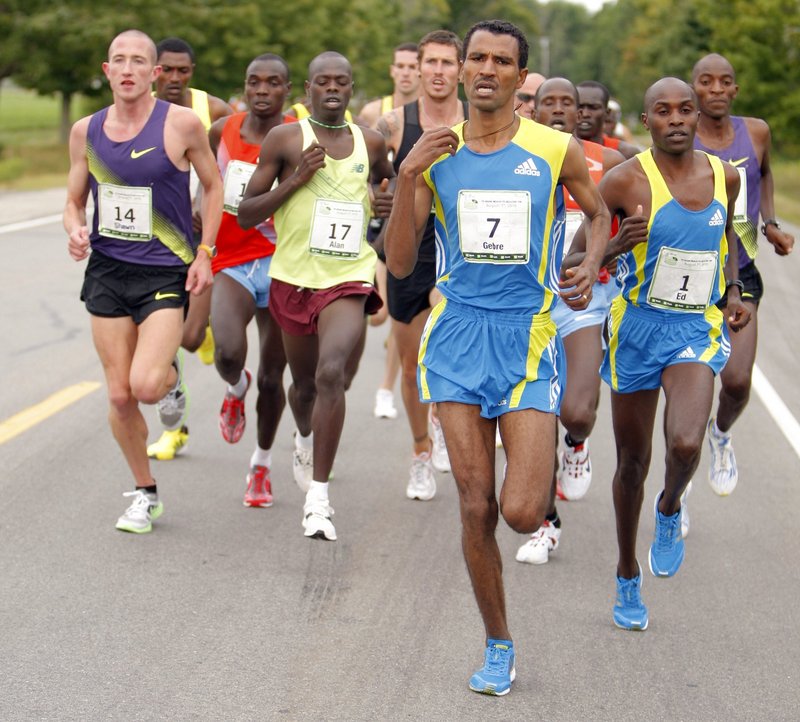When it comes to explaining the technological focal point of road racing, Pete Bottomley provides a fitting analogy for the timing chip.
“It’s much like an E-ZPass,” said Bottomley, a Cape Elizabeth resident and a Masters runner who will participate in his 12th TD Bank Beach to Beacon.
“It’s a magnetic strip that’s been programmed to activate at the starting line, and it registers your time when you’ve finished.”
The timing chip is an essential part of road racing and a vital part of the Beach To Beacon, the annual 10-kilometer race through Cape Elizabeth.
Since the race’s inception in 1998, a timing device no bigger than a quarter has been used to record each runner’s time from the starting line on Route 77 to the finish line in Fort Williams Park.
But Bob Teschek remembers the days when timing a road race meant handing out popsicle sticks to each runner to designate the order of finish and corralling them into finishing chutes.
“What most races did in the 1980s, is that you would gather runners, hand them a popsicle stick with a number on it and put them in chutes, where we could manually note their finish time,” said Teschek, the owner of the New Hampshire-based Granite State Race Services. “Times were kept aggressively.”
At this year’s Beach to Beacon, two ultra-high frequency timing chips will be embedded into each side of each runner’s bib.
The key to the function of the timing chip is crossing a mat at the race’s start line.
With more than 5,600 runners expected to participate in this year’s Beach to Beacon, there’s no room at the start line for all of them.
But when a chip is present in the electronic field of the mat, a runner’s start time is picked up, then picked up again when the runner crosses the finish line, and each runner’s net time is registered and calculated.
“It allows the back-of-the-packer, or anyone who’s even a few feet off the line, to get their actual time from the start to finish,” Bottomley said.
“If you were 100 people back, you wouldn’t cross the starting line for at least 20 seconds, and this technology allows you to cross the starting line and not worry about calculating your time.”
Teschek’s company provides the timing – and the timing chips – for the Beach To Beacon, and he explained that as road racing has evolved, so has its timing methods.
In years past at the Beach to Beacon, runners have threaded a shoelace through their timing chip, securing it to their shoe when they’ve tied their shoes. This year, chips are embedded in each runner’s bib.
“The first race I remember, you tied the chip through your shoelaces,” said Falmouth resident Mike Payson, who will run in his 12th Beach to Beacon.
“It’s confusing because you’re given a set of instructions on how to do it, and runners tend to be very superstitious and careful about their rituals. It was something that made you think, and you have to put (the chip) on the right shoe and do it the right way. Runners are also a bit paranoid, so there was the fear of it falling off.”
And technology is not foolproof.
“Every once in a while, there could be an error of some sort, and you have to trace it back,” said Dave McGillivray, the Beach to Beacon race director.
“It could be operator error or equipment error. It’s probably less than half a percent. It’s minimal. And sometimes that can be the runner’s fault, too, if a bib number is bent or a chip is broken, or they didn’t run across the mat that catches the time itself. You never know what causes the error.”
While the first of the elite runners are making their final turn towards the finish line, Teschek attempts to beat the clock in his own race.
Because there is no stable wireless frequency or connection between the start and finish lines, Teschek has to establish that connection the old-fashioned way – moving parts from Point A to Point B.
After the last runners cross the starting line, Teschek picks up a set of timing registration devices placed at the start line that pick up start times then hops into a police escort, which takes back roads in Cape Elizabeth to the finish line.
Teschek exits the car – sometimes less than two minutes before the first runner crosses the finish line – and immediately connects the devices to a laptop, and begins downloading start times into a computer.
The process of posting net-time results, Teschek said, can take up to 20 minutes. And, in the fashion of technology, there’s always room for improvement.
“There’s a demand for times,” Teschek said. “We’d like to be able to expedite that and get those (results) in real time. That’s the next technological step, and that would be the most efficient.”
Staff Writer Rachel Lenzi can be reached at 791-6415 or at: rlenzi@mainetoday.com
Twitter: rlenzi
Send questions/comments to the editors.



Success. Please wait for the page to reload. If the page does not reload within 5 seconds, please refresh the page.
Enter your email and password to access comments.
Hi, to comment on stories you must . This profile is in addition to your subscription and website login.
Already have a commenting profile? .
Invalid username/password.
Please check your email to confirm and complete your registration.
Only subscribers are eligible to post comments. Please subscribe or login first for digital access. Here’s why.
Use the form below to reset your password. When you've submitted your account email, we will send an email with a reset code.